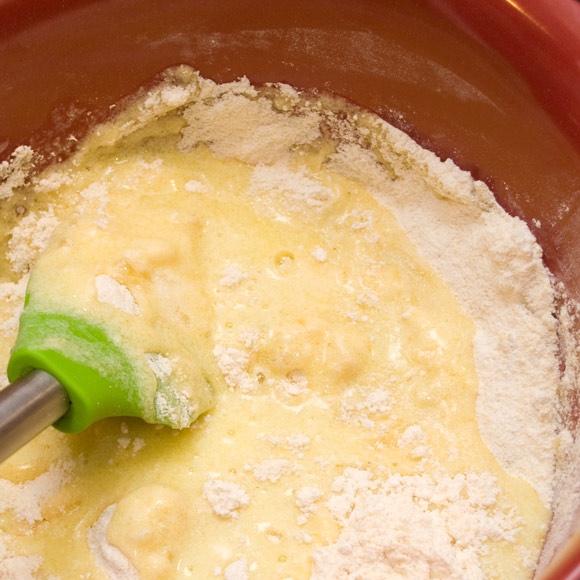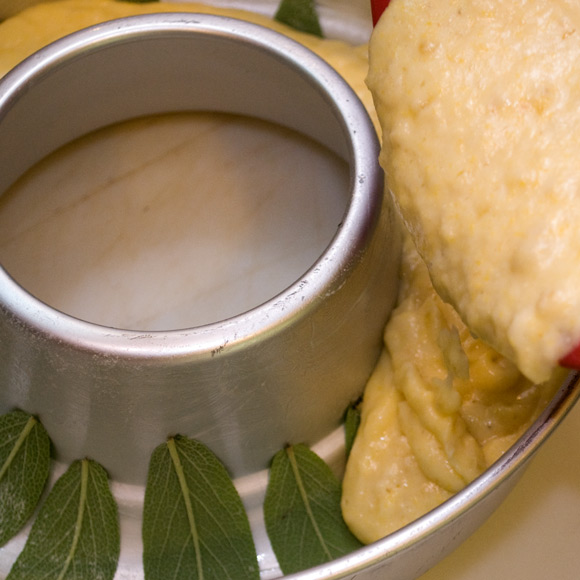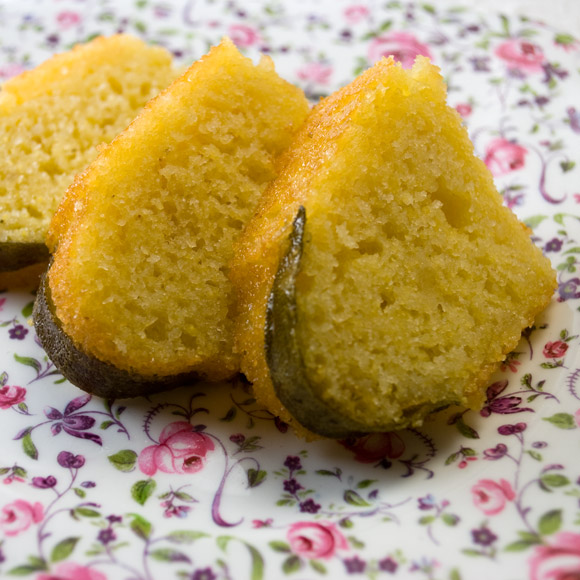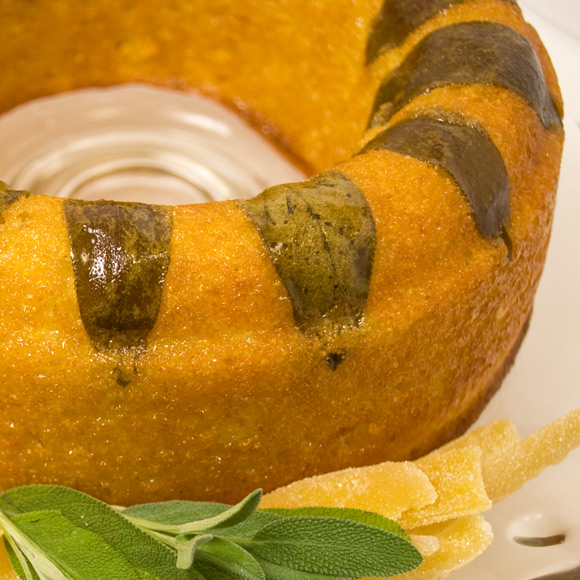A simple, yet memorable oil-based cake, redolent with candied lemon and the subtle flavor of fresh sage.
Sometimes I get lucky. I’ve been working on the quintessential lemon cake for years, and although I encountered a couple of formulas that are quite lovely in their own right, they are not exactly what I have in mind.
Today, after studying for the umpteenth time the lemon cake recipe grid I composed last year, which compares the ingredients, proportions, and mixing methods of a dozen lemon cakes from a dozen respected sources, I quickly threw together a simple cake, proportioned to fit my 7-cup tube pan, and by golly it worked. (To see what is involved in my recipe grid methodology, which I taught to students for years at the Northwest Culinary Academy, check out Recipe Grid: The Ultimate Chocolate Pudding).

The key differences between this new formula and others I tried is that I used oil instead of butter and the muffin mixing method instead of the more typical creaming method. The result is a somewhat dense, moist, tender, almost chewy cake with plenty of luscious lemon flavor.
The moist texture holds for at least 48 hours, plenty of time for a couple of determined adults to eat most of the cake (children may devour it sooner). Of course, you can also freeze a portion of the cake to enjoy later if you like.

A couple of caveats though.
I was seduced by a phenomenal picture of a lemon cake topped with candied lemon slices in the June/July 2009 issue of Donna Hay Magazine and spent an afternoon trying to get very thin slices of lemon that did not fall apart (firm lemons and a mandolin required) and then cooking them in sugar syrup for first 15 minutes as prescribed by the magazine (HA!). And then when I realized that only someone with a jaw of steel could chew these babies, for an hour, as prescribed by Martha Stewart.
Be forewarned: An hour of simmering produces barely chewable lemon rinds. You may need to cook them even longer.

However, in both of my early tests, the rind was so bitter that most folks would not appreciate it. To get rid of the bitterness in the rind, you must blanch the lemon peels at least three times in fresh batches of simmering water, and THEN simmer in syrup for an hour or longer. You can’t retain the shape of a lemon slice with all that simmering.
Thus, I gave up on the idea of a cake topped with translucent, shimmering candied lemon slices. Beauty is important, but taste is supreme.
This gave me the opportunity to rethink the flavor profile. A quick trip to the garden produced a handful of fragrant, silvery sage leaves that added the visual effect I felt the cake needed and also a subtle perfume of fresh sage. Perfect!

Luscious Candied Lemon Sage Tea Cake
This is the kind of cake that I treasure in my repertoire. It’s a simple, yet memorable cake, best served unadorned. It’s the perfect accompaniment to afternoon tea or coffee.
It’s also easy to make and doesn’t require creaming of butter, sugar, and eggs. If you have the Candied Lemon Peel, you can throw it together in a snap and be eating the most delicious, satisfying cake in less than an hour.
I’m crazy for cornmeal these days and throw it into cakes, muffins, cookies, and pancakes with wild abandon. The small amount added to this cake adds only the most subtle cornmeal flavor, but the additional textural element is most welcome.
baking spray (combination of vegetable oil and flour)
15-18 large fresh sage leaves
1½ cups all-purpose flour
½ cup fine yellow cornmeal
1½ teaspoon baking powder
½ teaspoon baking soda
½ teaspoon fine sea salt
1 cup sugar
1 cup buttermilk
¼ cup lemon juice
3 large eggs, lightly beaten
½ cup vegetable or light olive oil
1 teaspoon lemon oil (or 1½ teaspoons lemon extract)
½ cup chopped Candied Lemon Peel
Lemon Syrup
1 cup powdered sugar
¼ cup fresh lemon juice
- Coat a 7- to 8-cup capacity metal ring mold with baking spray.
- Position a sage leave, top side down, on the bottom of the ring mold so that the tip of the leaf will point downward on the outside of the cake when the finished cake is inverted onto a serving platter (refer to photo above). Continue in the same fashion with the placement of the remaining leaves, leaving about ?-inch free space between each leaf. Reserve.
- In a medium mixing bowl, sift together the flour, cornmeal, baking powder, baking soda, and salt. Whisk to thoroughly distribute the dry ingredients. Whisk in the sugar.
- In another medium mixing bowl, whisk together the buttermilk, lemon juice, eggs, oil, lemon oil and candied lemon peel until thoroughly combined.
- Pour the wet ingredients over the dry ingredients, and then fold quickly and gently to combine. (Overmixing will produce a tough cake.)
- Carefully pour the batter over the sage leaves in the ring mold. Level with a flexible spatula.
- Bake immediately at 350° for about 30 minutes. The top of the cake will be lightly browned (perhaps not evenly) and an instant-read thermometer will register 175° if inserted into the center of the cake. Also, a thin skewer inserted in the center of the cake will come out almost clean. (Do not overbake, or the cake will be dry.)
- In the meanwhile, to make the Lemon Syrup, combine the powdered sugar and lemon juice in a small saucepan, and bring to a simmer, whisking to dissolve the sugar. The syrup should go from foggy to clear just before it comes to a simmer. If not, reduce the heat and keep whisking until the syrup clears. Remove from the heat. Reserve
- Remove the cake from the oven and allow to cool for 15 minutes in the pan on a wire rack. Run a thin knife around the edge of the cake pan to ensure that the cake is not sticking to the pan anywhere. Then, invert the cake pan over a serving platter and carefully remove from the cake.
- Using a pastry brush, gently paint the cake with Lemon Syrup, using most or all of the syrup. The cake will absorb the syrup as you continue to add layers of syrup to it.
- With a damp paper towel, remove any syrup that has collected on the serving platter.
- Serve plain, dusted with powdered sugar, or with a cloud of whipped cream and a handful of fresh raspberries. May be served warm or at room temperature.
Makes 1 medium tea cake; serves 8 or more.
Copyright 2009 Susan S. Bradley. All rights reserved.


I have never cared for candied citrus despite my love of citrus so I think this is a definite improvement. Definitely memorable and definitely delicious. Pinned. And this: Beauty is important, but taste is supreme. is sheer genius. SO SO TRUE.
Unlike rhubarb, with which I am not so familiar, lemons and I are old friends. But your candied lemon peel is beautiful beyond even my lemon-obsessed dreams. I came to the same conclusion that you did – about needing to blanch it 3 times and simmer it in the simple syrup for an hour, but you’ve made your peel wide strips and that makes all the difference (at least aesthetically.) And as for the cake – wow! Those sage leaves make for a spectacular presentation, and I’ll be their scent in the cake is sublime. Pinning this to make soon!
This cake is absolutely stunning! I can imagine how aromatic it is too, with sage and lemon. It would be lovely for a special occasion spring meal!
Faith, thanks so much for stopping by. I followed you on Twitter.
Awesome idea! Will have to try this! Thanks for sharing!
Florian, thank! Now I’ll check out those cookies
Wow sage with lemon, what a neat idea. Flavor burst!
Michelle, thanks!
What an interesting idea to put sage in a cake, I would have never thought of it but I can see how it would work well with the lemon. Speaking of lemon, I LOVE candied lemon!
Sara, thanks for stopping by! Love your mini pancakes as ell.
I finally made this last night, after falling in love with you over the recipe matrix mentioned here. After tasting it, I am as ever your loyal subject. I really appreciate your relentless pursuit of texture, and I am so happy to have recipes from someone who is not afraid to let food say, “Lemon!” (a la decidedly lemon teacakes!).
For want of a bundt pan I used a muffin tin sans papers. They were perfect at 20 minutes. I didn’t want to put the sage under the muffin, and didn’t think it would work on top using any method. So, I steeped fresh sage in both the oil and syrup juice (warmed). The flavor came through beautifully, giving it a complex taste of a fresh garden, but not of sage per se. I also subbed candied peel with the zest of one large lemon.
I served them dusted with powdered sugar nestled among blueberries with a pair of teeny 1-cm sage leaves on the center muffin. Everyone tucked into them without looking back. I think I’m ready for batch #2.
Wow, Lorna, your interpretation sounds awesome. Fresh sage leaves are altogether different in character than their dried counterpart. They deserve broader use and appreciation. Steeping them in liquid as you did is a great way to infuse a dish with their subtle, complex flavor. Thank you for the very kind words.
The sage leaves look so lovely on top! And, the recipe sounds delicious with cornmeal, buttermilk, and candied lemon peel.
.-= lisaiscooking´s last blog ..Pozole Rojo =-.
Thanks so much, Lisa!
This looks amazing, I love that you used lemon oil and sage leaves. I am so into citrus at the moment this would go down a treat!
I really like the texture that oil gives to cakes and do it quite often.
.-= Jeena´s last blog ..Lemon meringue pie recipe =-.
Thanks Jenna! I seem to be using sage a lot all of a sudden. The garden is overflowing with it and the fragrance calls to me. Tonight I’m steeping it in hot milk, which when cool I will strain and add to a pumpkin cake I am working on. It’s really surprising how adaptable it is.
I seem to be using sage a lot all of a sudden. The garden is overflowing with it and the fragrance calls to me. Tonight I’m steeping it in hot milk, which when cool I will strain and add to a pumpkin cake I am working on. It’s really surprising how adaptable it is.
What a fantastic & creative idea!! and to use sage in a cake: wow!!
This is just heavenly!!!
.-= Sophie´s last blog ..Moroccan spiced chicken with a harissa, caper & onion potato salad =-.
Thanks so much Sophie! It was one of those happy failures that turns into a success. I tried the cake first with candied lemon slices on top and although that looks spectacular, the lemon slices are basically inedible. Then through the kitchen window I spied the buckets of sage in the garden. Viola!
delicious is the third word that comes to mind here. the first and second? elegant and classy.
.-= grace´s last blog ..a misnomer =-.
You are very kind, Grace, thank you so much.
This is absolutely gorgeous! I love sage (in both savory and sweet recipes) but haven’t tried it with lemon before. I have also run into the same issues with candying whole citrus slices – made candied lime slices that were pretty but unpleasantly bitter & chewy, and when I tried blanching they did indeed fall right apart.
Thank you, Anna! Sage and lemon are a marriage made in heaven. I’m already wondering what else I can partner then in. Yes, you and I had the same experience with the candied lemon slices. I wanted so badly to use them because they were gorgeous. Gorgeous AND inedible. Darn!
Sage and lemon are a marriage made in heaven. I’m already wondering what else I can partner then in. Yes, you and I had the same experience with the candied lemon slices. I wanted so badly to use them because they were gorgeous. Gorgeous AND inedible. Darn!
Lemon ring and vodka. A little lemoncello with this would be nice.
Ohhhh, Mark, that does sound like gilding the lily. I do have my own vodka, lemon peel brew. It’s the most gorgeous shade of yellow. Might be nice to put that in the final syrup ans coat the cake with it. Yum!
lovely!! wow! so there was a method to your madness with the candied lemon peel the other day.
.-= Danielle´s last blog ..Pineapple Casserole – A Taste of Yellow =-.
Oh yes, Danielle, there is always a method to my madness.
Thank you Christina and Food411! I didn’t realize the blog comments would put from Twitter. Very cool.